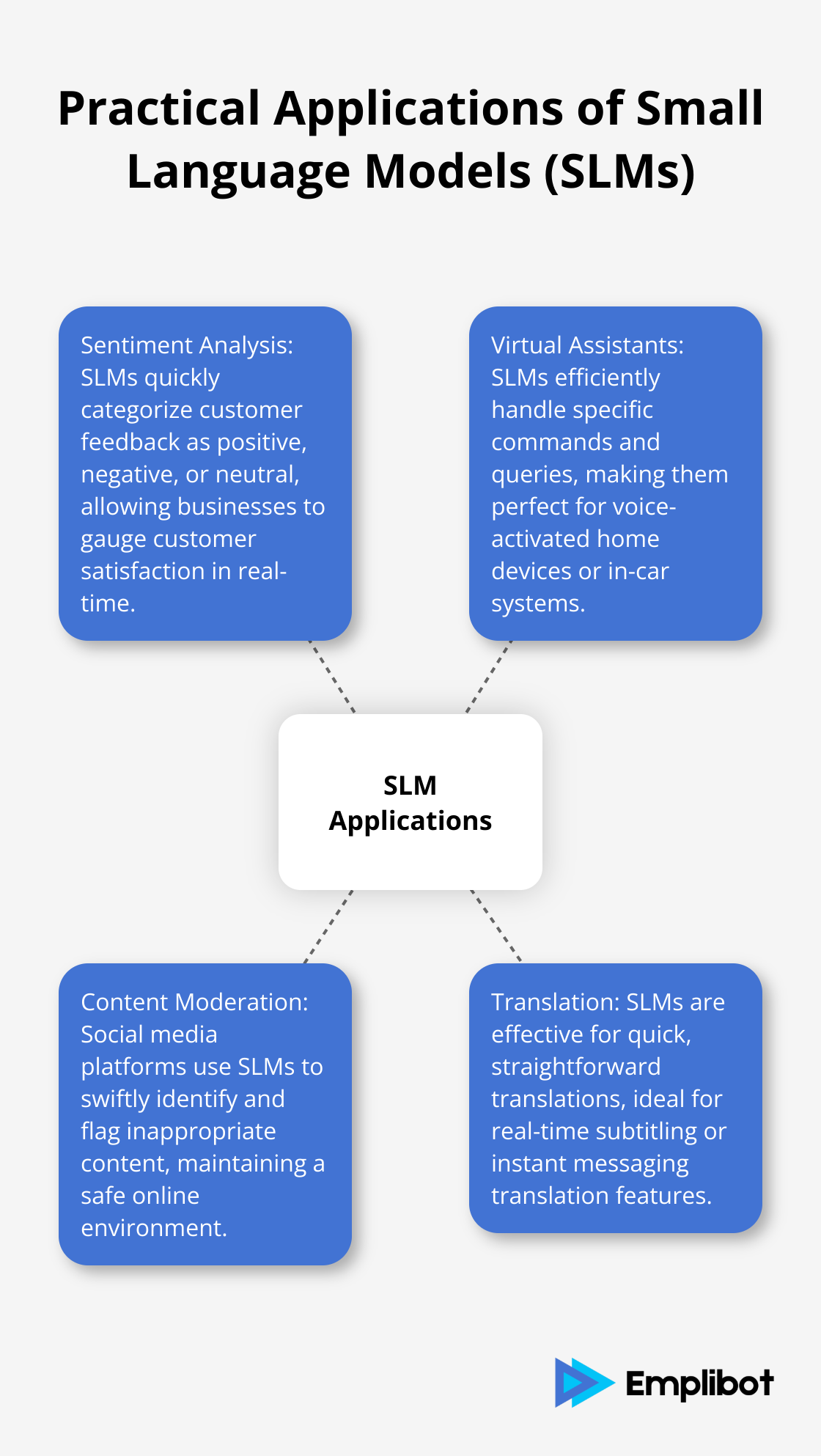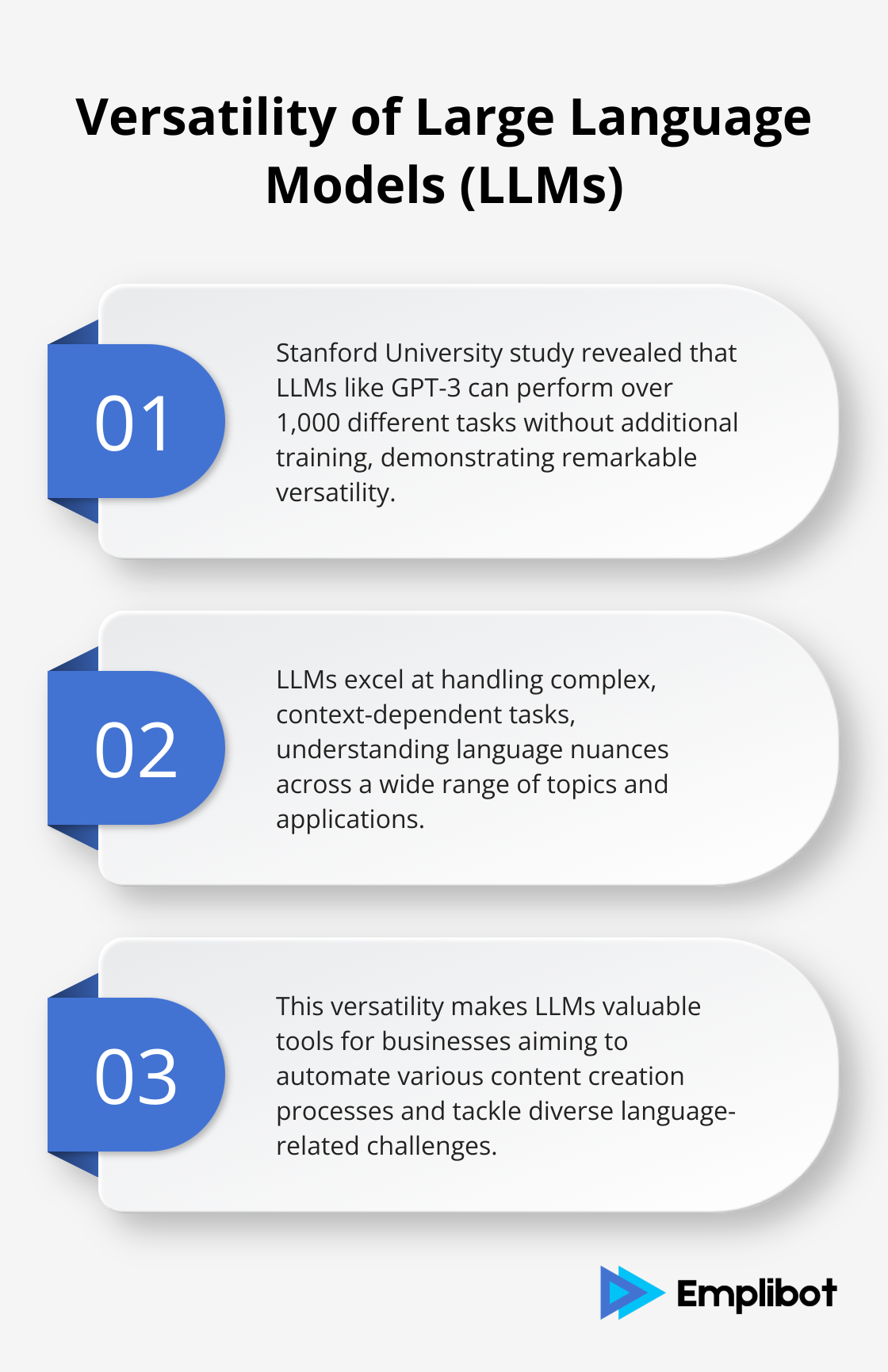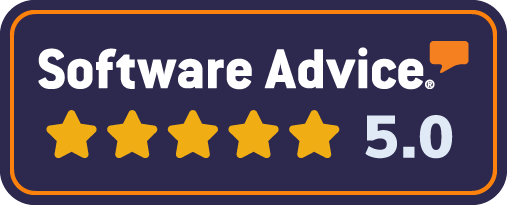At Emplibot, we’re fascinated by the rapid advancements in natural language processing. The debate between SLM vs. LLM has become increasingly relevant for businesses and developers alike.
Small Language Models (SLMs) and Large Language Models (LLMs) each have unique strengths and applications. In this post, we’ll explore when to use each type of model and provide practical examples to guide your decision-making process.
Contents
ToggleWhat Are Small Language Models
Small Language Models (SLMs) are compact, specialized AI systems designed for specific natural language processing tasks. These models typically have fewer parameters and are fine-tuned on a subset of data for a specific use case, making them significantly smaller than their large counterparts.
Speed and Efficiency of SLMs
SLMs excel in speed and efficiency. They process information much faster than Large Language Models (LLMs), often providing responses in milliseconds. This rapid processing makes SLMs ideal for real-time applications where quick responses are essential. For instance, a chatbot powered by an SLM can provide instant customer support, handling thousands of queries simultaneously without noticeable lag.
Resource-Friendly Nature
One of the biggest advantages of SLMs is their minimal resource requirements. Unlike LLMs that need powerful GPUs and extensive cloud infrastructure, SLMs can often run on standard computers or even smartphones. This makes them cost-effective and accessible for businesses of all sizes. A small e-commerce company could implement an SLM-based product recommendation system without investing in expensive hardware.
Practical Applications of SLMs
SLMs excel in focused NLP tasks. They’re commonly used for:

- Sentiment Analysis: SLMs quickly categorize customer feedback as positive, negative, or neutral. This allows businesses to gauge customer satisfaction in real-time and respond promptly to issues.
- Virtual Assistants: SLMs handle specific commands and queries efficiently, making them perfect for voice-activated home devices or in-car systems. They process simple requests (like setting alarms, checking weather, or controlling smart home devices) without the need for complex reasoning.
- Content Moderation: Social media platforms use these models to swiftly identify and flag inappropriate content, maintaining a safe online environment without the latency associated with larger models.
- Translation: SLMs are making waves in the translation industry. While they may not match the nuanced understanding of LLMs, they’re highly effective for quick, straightforward translations. This makes them ideal for real-time subtitling or instant messaging translation features.
As we transition to discussing Large Language Models, it’s important to note that while SLMs offer speed and efficiency, they have limitations in handling complex, context-dependent tasks. This is where LLMs come into play, offering a different set of capabilities and use cases.
What Are Large Language Models
The Power of LLMs
Large Language Models (LLMs) stand as the titans of natural language processing. These sophisticated AI systems, such as ChatGPT, Claude, or Google Gemini, are powered by complex architectures and train on vast amounts of data. They understand and generate human-like text across a wide range of topics and tasks.
Versatility in Action
LLMs excel at handling complex, context-dependent tasks. They understand language nuances, making them ideal for applications that require deep comprehension and generation of human-like text. GPT-3, for example, writes convincing news articles, creates marketing copy, and even generates code snippets.
A Stanford University study revealed that LLMs like GPT-3 can perform over 1,000 different tasks without additional training. This versatility makes them valuable tools for businesses aiming to automate various content creation processes.

Context Understanding and Generation
The true strength of LLMs lies in their context understanding and generative abilities. They maintain coherence over long passages of text, understand implicit information, and infer unstated details. This makes them particularly useful for tasks like:
- Content Creation: LLMs generate blog posts, articles, and even books on a wide range of topics. (AI-generated content is becoming increasingly common in journalism and publishing.)
- Language Translation: LLMs offer more nuanced and context-aware translations compared to traditional machine translation systems.
- Conversational AI: LLMs power sophisticated chatbots and virtual assistants that engage in human-like conversations. Companies have demonstrated chatbots that discuss complex topics like philosophy and science with remarkable coherence.
Popular LLMs in Action
Several LLMs have gained prominence for their impressive capabilities:
GPT-3: This model creates AI-powered writing assistants, chatbots, and even generates computer code. GitHub Copilot, built on GPT-3, helps developers write code faster and more efficiently.
BERT: Google uses BERT to improve search results by better understanding the context of search queries.
XLNet: This model shows superior performance in tasks like sentiment analysis and question answering. Financial institutions use XLNet for more accurate market sentiment analysis and risk assessment.
Challenges and Considerations
While LLMs offer impressive capabilities, they also present challenges. They require significant computational resources and can be expensive to run. Additionally, their outputs can sometimes be unpredictable or biased, requiring careful monitoring and fine-tuning.
As we move forward, it’s important to consider how these powerful models compare to their smaller counterparts. The next section will explore the key differences between LLMs and Small Language Models (SLMs), helping you determine which type of model best suits your specific needs and use cases.
SLM or LLM: Which Model Fits Your Needs?
Task Complexity and Scope
Small Language Models (SLMs) excel in specialized, narrow tasks. A customer service chatbot that handles common queries about return policies or product information can effectively use an SLM. These models provide quick, straightforward responses to predictable questions.
Large Language Models (LLMs) are the preferred choice for complex, open-ended tasks. Content creation, in-depth analysis, and creative writing benefit from LLMs’ broader knowledge base and context understanding. A marketing agency that uses AI to generate comprehensive product descriptions across various industries would likely choose an LLM.
Resource Considerations
Resource availability plays a significant role in model selection. SLMs require fewer computational resources, resulting in lower costs and energy consumption. A small e-commerce business could implement an SLM-based product recommendation system on standard hardware, which keeps costs low.
LLMs demand substantial computational resources. Training OpenAI’s GPT-4 reportedly cost more than $100 million, with some estimates ranging up to $78 million in compute cost. This makes LLMs more suitable for larger enterprises or specialized applications where the benefits outweigh the costs.

Speed vs. Accuracy Trade-offs
SLMs offer lightning-fast responses (often in milliseconds). This makes them ideal for real-time applications like live chat support or instant language translation in messaging apps. However, they may sacrifice some accuracy or nuance in complex scenarios.
LLMs provide more accurate and nuanced responses but at the cost of speed. They suit tasks where response time isn’t critical, such as generating long-form content or conducting in-depth data analysis. A financial institution that uses an LLM for risk assessment would prioritize accuracy over speed.
Real-world Applications
In practice, many businesses use a combination of SLMs and LLMs. A social media management platform might use SLMs for quick sentiment analysis of user comments and LLMs for generating thoughtful responses to complex customer inquiries.
E-commerce giants employ SLMs for rapid product search and categorization, while they use LLMs for generating detailed product descriptions and answering nuanced customer questions.
News organizations often use SLMs for real-time event categorization and trending topic identification, while they rely on LLMs for in-depth article summarization and fact-checking.
Emplibot’s Approach
Emplibot leverages the power of LLMs for its autoblogging feature. This allows the generation of high-quality, contextually relevant content that mimics human writing styles across various industries and topics. The use of LLMs ensures that the content produced is not only grammatically correct but also engaging, informative, and tailored to each client’s unique voice and audience.
The choice between SLMs and LLMs isn’t always clear-cut. It often depends on a careful analysis of specific needs, resources, and goals. As AI technology continues to evolve, we’re likely to see even more specialized models emerge (further blurring the lines between SLMs and LLMs) and offering even more tailored solutions for businesses across industries.
Final Thoughts
The debate between SLM vs. LLM highlights the unique strengths of each model type. Small Language Models offer speed and efficiency for specific tasks, while Large Language Models excel in versatility and complex problem-solving. The future of language model development will likely bring more specialized and hybrid models, combining the best features of both SLMs and LLMs.
Businesses must consider task complexity, resource availability, and speed-accuracy trade-offs when choosing between SLMs and LLMs. Some organizations might benefit from using both model types, leveraging each where it performs best. As AI continues to evolve, staying informed about different language models’ capabilities will help companies make strategic decisions in implementing AI solutions.
For businesses looking to harness AI for content creation and marketing, Emplibot offers a comprehensive solution. Emplibot automates WordPress blogging and social media management, producing high-quality content tailored to your business needs. This approach allows companies to increase their online presence and drive traffic, leads, and sales without extensive manual effort.


![Google Business Profile Optimization [Local SEO]](https://wp.emplibot.com/wp-content/uploads/emplibot/google-business-profile-optimization-hero-1756624038-768x456.jpeg)



![SEO Content Creation [Tips and Techniques]](https://wp.emplibot.com/wp-content/uploads/emplibot/seo-content-creation-hero-1756278494-768x456.jpeg)



